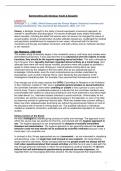Samenvatting
Samenvatting alle artikelen Youth and Sexuality 2023/2024
- Instelling
- Universiteit Utrecht (UU)
Dit is een Engelse samenvatting van alle literatuur van youth & sexuality geschreven in 2024. Alle artikelen voor het tentamen zitten erin: Lecture 1a. Sexuality research in the past century and now (Jenneke van Ditzhuijzen) • Bullough, V. L. (1998). Alfred Kinsey and the Kinsey Report: Histo...
[Meer zien]














